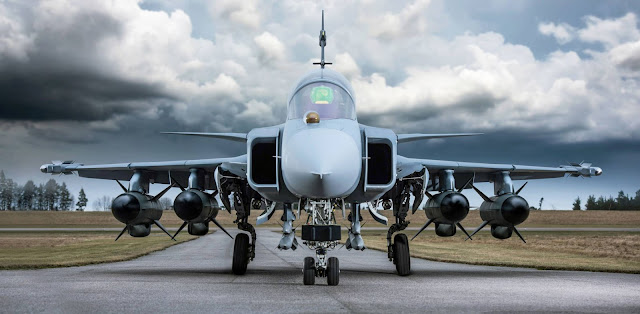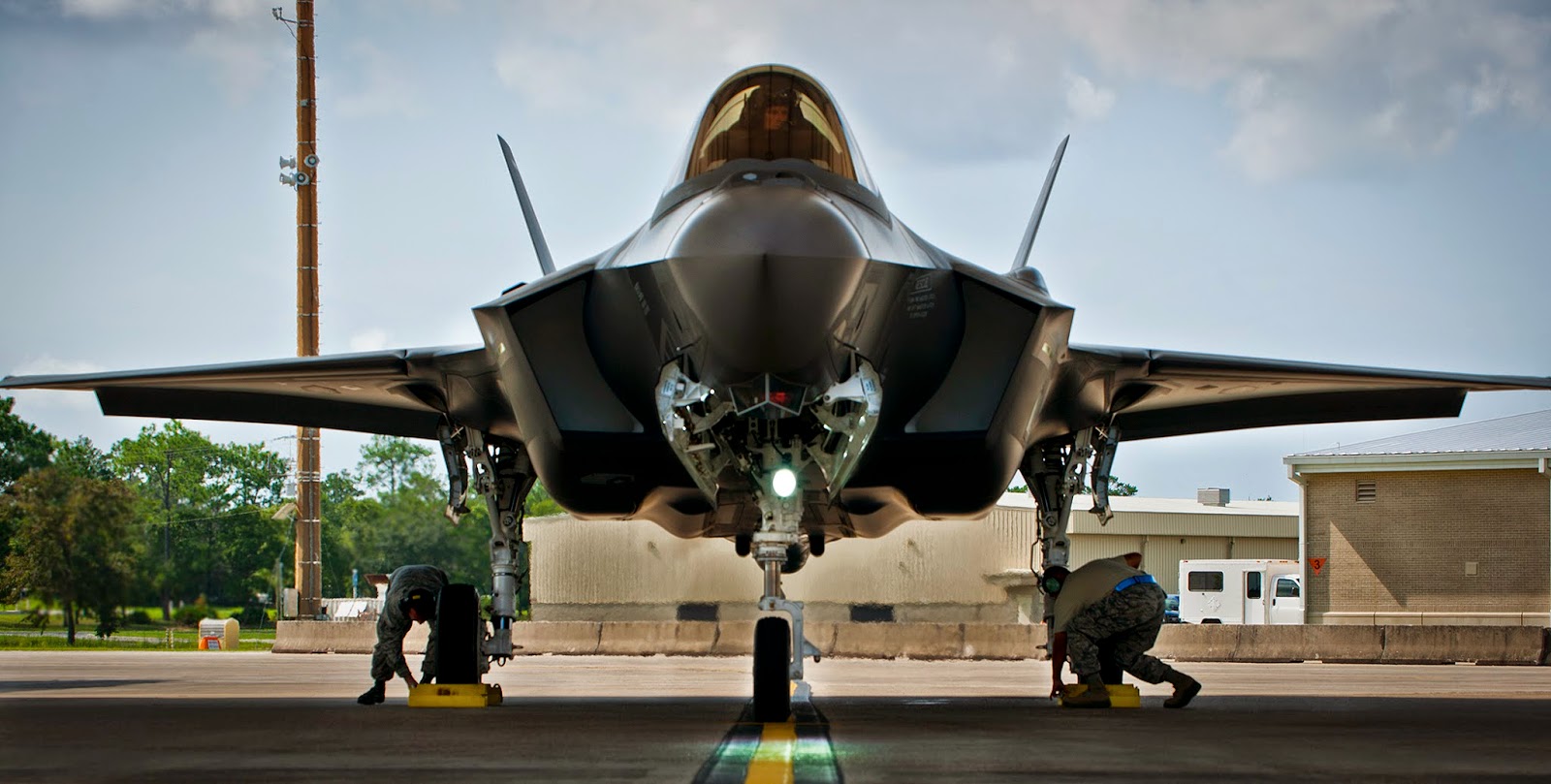Reality check: Will Canada need an interim fighter?
 |
| Will it be ready in time? |
Canada's fighter "reset" seems to still favor the F-35. Saab has dropped out of the running on the grounds that the deck is stacked in Lockheed Martin's favor. Contracts are still being signed, and, for all intents and purposes, the JSF is still likely to be Canada's CF-18 replacement.
The trouble is... It's probably going to be late.
Despite assertions to the contrary, stating that the F-35A will be entering "initial operational capacity" (IOC) with the USAF in December 2016, the possibility of replacing Canada's CF-18 fleet with Lightning IIs by 2020 is looking grim. For one thing, the F-35s IOC will be extremely limited in terms of combat ability with the "go to war" Block 3F software unavailable until the latter half of 2017. The kicker here is the numbers involved, between 12 and 24.
Of course, there is always the very real chance of the F-35 program getting delayed further. Either due to funding cutbacks, or further development issues. The "good" news is that the F-35 is pretty much considered "too big to fail" in that outright cancellation seems impossible.
To put it simply, if the USAF, the JSF's biggest costumer (and bankroller), will be lucky to put a dozen or two operational F-35s in the air by 2018... What chance does Canada have in replacing its CF-18 fleet by 2020?
If the federal government is still keen on purchasing the F-35, "reset" notwithstanding, then it's about time Canada develops a contingency plan. That could mean either doing without fighters for a few years, a service life extension plan (SLEP) for the CF-18 already in service, or purchasing some sort of interim fighter until the F-35 becomes available and operational.
Obviously, making do without fighters is not a viable option.
 |
| The CF-18: Starting to show its age. |
Extending the life of the RCAF's current CF-18 fleet may be an option, but the fighters are already 30 years old. They have already gone through two upgrade programs, and, as the aircraft get older, they become much more expensive to maintain. The RCAF was concerned about the extra wear-and-tear caused by deployment in Libya. Flying a 40-year-old aircraft isn't an attractive option by any means, especially when that aircraft is tasked with aerial dominance.
The only real solution is an interim fighter. But which one?
 |
| Canadian Gripen: It could still happen! |
One option is the Saab Gripen. Although it is currently out of the running to directly replace the CF-18, it could prove to be an attractive option as either a short term solution, or as a lower cost supplement to an F-35 fleet. Saab has started assembly of its first single-seat Gripen E, and older C and D models may still be available. (More about the possibility of a Canadian Gripen at gripen4canada.blogspot.ca)
 |
| Lightning IIs plus Super Hornets? |
The F-18E/F Super Hornet, already being considered as a F-35 alternative, could be purchased as an interim fighter as well. Australia has already chosen the Super Hornet as an interim fighter that will also supplement its future JSF fleet. With the ability to convert some to "Growler" electronic warfare (EW) capability. Like Canada, Australia is a large country that chose the F/A-18 years ago. The Super Hornet seemed like a natural choice. The Super Hornet has not been as affordable as initially thought, however with operating costs coming in at over $24,000 per flight hour. Apparently, economies of scale seen for its use in the United States Navy (USN) don't translate well into smaller fleets. Some questions have also been raised as to the effectiveness of the Super Hornet against more modern versions of the Russian Flanker.
 |
| The Eurofighter Typhoon |
Buying new Typhoons isn't the only option however. As the newest version of the Typhoon, the Tranche 3, enters service, cash-strapped European nations are looking to rid themselves of older (Tranche 1) inventory. EADS (one of the Eurofighter partners) recently offered 22 used Typhoons to Switzerland, Spain has offered 18 used Typhoons to Peru, and Germany is considering selling some of its surplus fighter inventory to Bulgaria. Canada has had issues with purchasing used military equipment with a British pedigree, but there is a world of difference between used fighter jets and mothballed submarines.
Of course, one of the biggest stumbling blocks to buying any interim fighter is the extra cost associated with maintaining a two fighter fleet. Separate supply lines, additional training costs, and different infrastructure is needed to accommodate jets of different sizes and requirements. Often, the cost of flying a single, more expensive aircraft type is less than that of multiple, cheaper platforms.
Of course, that begs the question... Why buy an interim fighter as a stop-gap until the F-35 becomes available? Why not simply purchase a fighter aircraft that will be ready when we need it? The Super Hornet, the Rafale, and the Typhoon are all operational and in production now. Is the F-35 worth the extra wait?



Its going to be interesting going forward for sure. The latest poll say that 51% of Canadians wouldn't consider the Conservatives as there next government. Where does this leave the F-35? I wonder how the Liberal and NDP parties plan to handle this. Something tells me the Liberals may want push this through as they originally joined the project (and continue there stellar procurement record....insert sarcasm here) . The NDP may not. A minority government may mean a F-35 choice. Its interesting to watch the politics in Italy they may give a clue to a battle brewing in Canadian politics. I wonder if making due without fighter is an option. If Canada chooses the F-35 Could it not apply for NATO air policing similar to Iceland and the Baltic states? It could pay the costs until the F-35 is ready. It would be awesome to see Typhoons, Gripens, or Rafales defending Canadian airspace in co-operation with our allies......
ReplyDeleteOne option I could see happening, with the US trying to lower some costs is that we may lease fighters off them for the intern.
ReplyDeleteI'm not sure if that would work. The US is also waiting for the F-35, and its unlikely they would agree to reducing their fighter force in the meantime. Also, their F-18s (the obvious and easiest choice) are getting old and beat up after years of carrier use.
ReplyDeleteThere is the possibility of obtaining aircraft from AMARC, but these aircraft have been out of service for years and would require a lot of time and money to usable.
http://amarcexperience.com/AMARCArticleF18Hornet.asp
Typhoon seems to be the best alternative: good BVR & WVR with large industrial & user base. The operational cost should drop (as per Austrian's experience with their 15-ship Typhoon fleet) gradually as logistics gets streamlined and spare parts secured. Besides, there are about 50+ airworthy Trench 1 airframes already or about to enter the market at about $70 million a piece. Typhoon also works well by itself and when teamed up with American Raptor & F18EFG as allies exercises demonstrate.
ReplyDeleteOn a separate note, as far as cost and perhaps capability are concerned, buying F35 [vs. Typhoon/Gripen] would be akin to buying F14/15 [vs. F16/F18] back in the 1970's. (Deja vu!) Unnecessarily complex & expensive, IMHO.